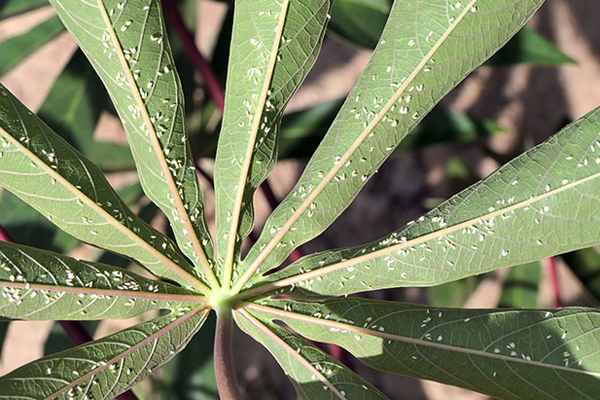Whitefly: Scientists make breakthrough

Cassava leaves infested with whiteflies. Photo/Lominda Afedraru
What you need to know:
Whiteflies are tiny white flying insects that collect on the undersides of green cassava leaves. They pierce and suck sap from the leaves, leaving spots leading to yellowing of leaves and stunted growth
Scientists from National Crop Resources Research Institute (NaCRRI) led by Dr Chris Omongo have made a breakthrough in the fight against the destructive whiteflies.
The whiteflies cause the spread of two deadly cassava diseases such as Cassava Brown Streak Disease (CBSD), which leads to root rot, and Cassava Mosaic Virus (CMV), which shows in yellowing and wrinkled leaves.
These diseases are spread by whiteflies during flowering in two ways; either by causing direct damage thereby injuring plants by sucking juices from them, causing leaves to yellow, shrivel, and drop prematurely or inserting several viruses from diseased to healthy plants through their mouthparts.
The former leads to CMV while the latter can cause both diseases with the deadliest being CBSV.
The technology
Dr Omongo reveals that a concerted assault against CBSD, started in 2015 with the help of funds from Bill and Melinda Gates Foundation. A team of more than 20 researchers have now cracked the whitefly genetic building block and put it under scrutiny under the African Cassava Whitefly Project (ACWP). In the study undertaken, researchers from the ACWP collected cassava field populations of the whitefly species from Buikwe, Serere, Pallisa, Bugiri and Luweero districts.
The colonies were then selectively inbred in quarantine facilities such as greenhouses, screen houses and laboratories. Researchers determined the order of the chemical building blocks that make up the genetic information of the whitefly, a process called genome sequencing.
The development is set to improve understanding of gene interactions between the vector and the viruses it hosts and provides a basis for coming up with management interventions.
Confidor pesticide
According to Dr Omong, the researchers used confidor insecticide during the trials. Here, the cassava stalks are soaked in confidor pesticide which is recommended by agronomists. After soaking, the stalks are then removed from the basin for planting.
Another way involves farmers spraying the solution of confidor pesticide on the sprouting leaves of cassava after two months of planting.
Varieties
According to Dr Omongo the varieties under testing which include Narocas 1, and Nase3 will be released to the farmers later this year.
About whiteflies
Whiteflies are tiny white flying insects that collect on the undersides of green cassava leaves. They pierce and suck sap from the leaves leaving spots and causing yellowing of leaves and stunted growth. White flies attack may go unnoticed when populations are low.
The easiest way of identifying the insects is by gently shaking the plant. You will notice that they rise in a cloud above the plant.
Because white flies deposit honey dew on the leaves, they attract ants which in turn protect the white flies from natural enemies. For this reason, elimination of ants is critical for effective control of whiteflies.




